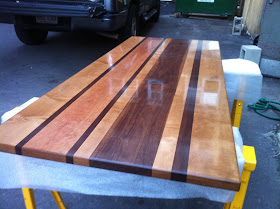 In furniture-making, drilling pilot holes to a certain depth is not uncommon. For worry-free and accurate work, it's nice to have a depth stop collar: something to stop the drill once it reaches the desired depth in the workpiece.
In furniture-making, drilling pilot holes to a certain depth is not uncommon. For worry-free and accurate work, it's nice to have a depth stop collar: something to stop the drill once it reaches the desired depth in the workpiece. So the question is: are all depth stop collars the same, and, if not, which is the best?
I am happy to report that the best functioning stop collar is also the least expensive. It's the plastic design, shown in this picture. You can get them at Woodcraft, Rockler, or Lee Valley, for about $6.
Now, when I was looking for a picture (and the name) of these handy devices, I came across a this entry on Toolmonger.com. I can tell you right now: the comments on Toolmonger are very negative regarding these depth collars. but I didn't find any of the negative comments to be true to my experience, and I have to wonder if many of the people who claimed to have used them really have, or whether they just bought them...and then traded "up" to metal collars assuming the bright red plastic ones are junk.
The truth is, these plastic collars are better than metal collars in a couple of ways: First, they don't have set screws to mar the cutting edge on your drills. Second, since they don't use set screws, you can set them anywhere on the drill and they won't slip. Metal collars with set screws often have the problem of the set screw getting bumped off the drill and into a gullet, and loosening the collar in the process.
I have been merciless with these collars, whereas with the metal collars I proceed gingerly because I don't want to bump the collar and loose the stopping action right when I need it. The plastic collars never move, no matter how hard you bash them against the work. Between the large and small sizes that came in the package I bought, they fit nearly any drill, including Kreg Pocket Hole Drills and Miller Dowel Stepped Drills.
My verdict: don't believe the hype, save your money (and your drill edges), and buy plastic.











